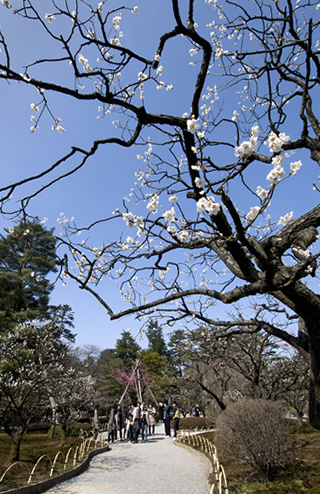

What is Kenroku-en?
Kenroku-en,a strolling-style landscape garden counted as one of the three noted gardens in Japan
Historical and Cultural Heritage Reflecting the Kaga Hyakuman-goku Culture
Along with Kairaku-en in Mito and Koraku-en in Okayama, Kenroku-en stands as one of the three most beautiful gardens in Japan. During the Edo period (1603 - 1868), Kenroku-en was founded and extended over generations by the feudal lords of Kaga (current southern part of Ishikawa) as a typical Daimyo (feudal lord) garden. Located in the heart of Kanazawa, it has been appreciated by both citizens and tourists from all over the world as a landscape garden that shows a different flavor in each season.
Strolling-Style Landscape Garden Arranged with Ponds, Hills and Tea Houses on a Wide Scale
By introducing the element of the “strolling-style” garden, Kenroku-en is laid out with a variety of gardening techniques from different periods. Unlike the sit-and-view style garden where you enjoy the landscape only from a certain spot of a temple or a palace, the strolling-style garden has large ponds, hills, cottages and tea houses arranged on a spacious ground, allowing you to take a walk through them. Because of the geographic features such as winding streams connecting several ponds and artificially built hills with a variety of trees, this style is also referred to a “strolling-style landscape garden incorporating ponds and hills”.
A Reflex of Feudal Lords Wishes for Prosperity
Kenroku-en was developed to perfection over generations by the Kaga clan lords. The basic concept of gardening, however, was “eternal life” consistently. By creating a large pond to resemble the ocean and arranging an island for a legendary wizard with the secret perpetual youth and longevity to live there, the lords cast their wishes for longevity and eternal prosperity into the design of the garden. The 5th lord, Tsunanori Maeda, the founder of the garden, established three divine islands, Horai, Hojo and Eisyu, in the Hisago-ike pond, and the 13th load Nariyasu Maeda also built Horai island in Kasumiga-ike pond.
Literature and Noh Chant Represented in the Landscape
The garden is designed to incorporate particular subjects from other scenery, literature and Noh chant lyrics. In addition to this, unique Kotoji stone lantern with imbalanced legs and the elaborately designed stone pavement with a diamond pattern.
